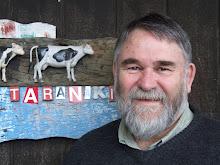 Paul Hutchinson and Dale Copeland create - habitually!
Paul Hutchinson and Dale Copeland create - habitually!Check out Dale's web site for the latest Virtual Tart exhibition and Paul's painting a day [now that's creative habit for you!]
From Dale: "The exhibition for September on http://virtual.tart.co.nz is Introversion Boxes, by Lisa Mei Ling Fong of San Francisco. I met Lisa at as Assemblage Exhibition in Berlin and have long admired her work. (And envied her too, for living close to The Bone Room, which must be the best shop in the world if you're an assemblage artist!)And while you're on the site, have a look around the Showcase ... there's new work there from me, from Anne Holliday, from Tony Rumball, Sharyn Lee Hoskin .....You might be interested: Paul has been trying to break into the USA art world. He has sold two of his small painting-a-day works on eBay, and has just put another one on.
All of the small paintings are on his http://postcardfrompuniho.blogspot.com site and his latest eBay one is on http://cgi.ebay.com/ws/eBayISAPI.dll?ViewItem&item=150362559587
It's a big market out there, and lots of different ways to find your audience."










